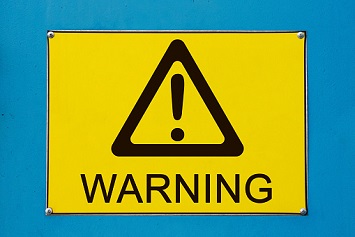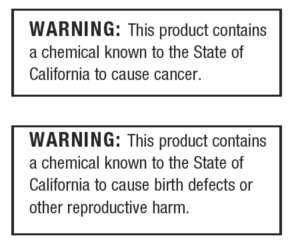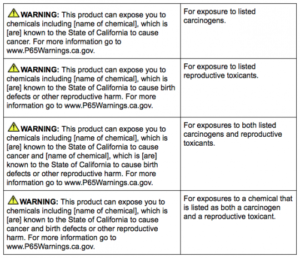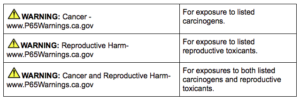Proposition 65, or Prop 65, product-safety warnings, once eye-catching and nerve-wracking, have become so ubiquitous that many would contend they have lost their intended effect.
Many businesses, facing steep penalties for non-compliance, appear to have adopted the practice of slapping a Prop 65 warning label on every product—even if the product does not trigger Prop 65 warning requirements—just to be safe from bounty hunting, class action lawyers. Appearing on everything from hotel room doors to padlocks to coffee shops, many Californians disregard Prop 65 warnings.
However, change is brewing. Significant Prop 65 amendments take effect on August 30, 2018, and will alter, among other things, labeling requirements, warning responsibilities, and safe-harbor protections. With less than two months until the new regulation is operational, now, more than ever, is a good time to familiarize yourself with the upcoming changes and ensure that your business will be in full compliance.
Background
Prop 65, formally known as the Safe Drinking Water and Enforcement Act, was enacted by California voters as an environmental ballot initiative in 1986. It is intended to protect California citizens from chemicals that were suspected to cause cancer and/or reproductive harm. In essence, Prop 65 is purely a consumer warning law, and it is often satisfied by the placement of an appropriate label on a product sold to California customers that presents a risk (under the State of California’s guidelines) of cancer or reproductive harm.
Administration
The Office of Environmental Health Hazard Assessment (OEHHA) administers Prop 65 and is responsible for determining if a chemical meets the scientific and legal requirements for placement on the Prop 65 toxic chemical list. A chemical is listed if it has been classified as a carcinogenic or reproductive toxin by one of the following agencies:
- S. Environmental Protection Agency
- S. Food and Drug Administration
- National Institution of Occupational Safety and Health
- National Toxicology Program
- International Agency for Research on Cancer
Requirements
The Governor of California is required annually to publish the chemical list, which includes chemicals that are present in the products that Californians purchase, extant in homes or workplaces, or released into the environment. The list is a moving target: chemicals are added and removed often, and, since the list was first published in 1987, it has grown to over 900 chemicals. The list includes common chemicals like: lead and lead compounds, engine exhaust, tobacco smoke, alcoholic beverages, and phthalates.
Prop 65 warning requirements apply to any person “in the course of doing business” with ten or more employees, but it does not apply to government agencies and public water systems. To comply with Prop 65, businesses must provide a “clear and reasonable” warning at or before the point of purchase of any product that exposes a Californian to any detectable amount of a carcinogenic or reproductive toxin.
However, businesses do not need to provide warnings if a listed chemical occurs at an OEHHA-determined safe-harbor exposure level for that chemical. Not all chemicals, it should be noted, have safe-harbor levels. Where no such safe harbor exists, a determination of whether a label is required may entail an often costly toxicological exposure analysis based on vectors of exposure as a result of the use of the product over time. Businesses are not required to provide warnings if exposure to a carcinogenic toxin occurs at a level that poses no significant risk (exposure would not result in more than one excess case of cancer in 100,000 individuals exposed to the chemical over a 70-year lifetime) or if exposure to a reproductive toxin produces no observable effect at the maximum dose level (exposure is below the OEHHA determined “no observable effect level” divided by 1,000). Testing can be expensive, so to cut costs and insulate themselves from liability, some businesses, as explained earlier, slap a generic label on every product without determining a chemical’s exposure level. (Note that it is likely illegal to put a warning label on a safe product, but this has not been the subject of class action litigation as products without labeling are those that generally trigger demand letters.)
The current safe-harbor warnings are provided in Illustration A below, but businesses may use their own “clear and reasonable” warnings to protect themselves from enforcement actions.
Enforcement
The California Attorney General and designated city officials (for cities with more than 750,000 people) are primarily responsible for enforcing Prop 65, but Prop 65’s “bounty hunter” provision incentivizes enforcement by private plaintiffs. Under the provision, 25% of the penalty collected is awarded to individuals bringing a successful enforcement action. Because penalties can be high—up to $2,500 per violation per day—lawyers “[scour] the landscape for products that ought to have been labelled, but weren’t,” as we wrote in our November 10, 2017 article. The process looks like this: a lawyer or consumer litigation group purchases a product in California, tests the product for a listed chemical, and then threatens (or brings) a lawsuit to coax an expensive settlement.
Even if a business thinks it will win in an enforcement action, settlement is often the cheapest option. Stuck between a rock and a hard place, it is no wonder that some businesses over-label their California-bound products.
Time for a Change
Prop 65’s many deficiencies prompted OEHHA to adopt amendments for the provision of “clear and reasonable” warnings. The new regulation, which was formulated in August 2016, takes effect on August 30, 2018. During the transitional grace period, the old rules govern, but businesses should immediately prepare for the new changes to iron-out any issues before the new regulation is operational.
OEHHA regulators hope to accomplish several goals with the new regulation, namely: making warnings more meaningful and useful to the public; reducing “over-warning;” and giving businesses clearer guidelines on how and where to provide warnings. Key changes worked by the new regulation will affect retailers’ responsibilities and impose new obligations on online and catalog sales.
New Labeling Requirements
Content
Under the new regulation, safe-harbor warnings must identify at least one chemical that prompted the warning for each endpoint (carcinogenic or reproductive toxicity). Additionally, to qualify for the Prop 65 safe-harbor, warning labels must feature: a triangular yellow warning symbol; the signal word, “WARNING;” “can expose” instead of the old “consists of” language; varying type-size requirements; and the internet address for OEHHA’s Prop 65 warnings website, https://www.P65Warnings.ca.gov. Sample safe-harbor warnings are provided in Illustration B.
Foreign Languages
The new regulation creates obligations for warnings provided in languages other than English. The regulation states: “Where a sign or label used to provide a warning includes consumer information about a product in a language other than English, the warning must also be provided in that language in addition to English.”
The content of the label ultimately governs. Therefore, an easy way to comply with the language requirement likely is to provide separate Prop 65 and consumer information labels.
Safe-Harbor Warning Methods
Although not required, businesses should take advantage of the new “clear and reasonable” safe-harbor warning methods to stave off potential Prop 65 enforcement actions. The four methods are:
- A product-specific warning provided on a posted sign, shelf tag, or shelf sign, for the consumer product at each point of display of the product.
- A product-specific warning provided via any electronic device or process that automatically provides the warning to the purchaser prior to or during the purchase of the consumer product, without requiring the purchaser to seek out the warning.
- A warning on the label that complies with the content requirements in § 25603(a) of the amendment; namely, the warning symbol, the signal word (“WARNING”), and the applicable warning message.
- A short-form warning on the label that complies with the content requirements in §25603(b) of the amendment; namely, the warning symbol, the signal word (“WARNING”), and the applicable truncated warning message.
To qualify for safe-harbor protection, the warning labels must be prominently displayed, likely to be seen, and understandable by the average person under customary conditions of purchase. Labels may be affixed directly to the product or its immediate container or wrapper.
The amended safe-harbor provision will not override pre-existing court-approved settlements that require a specified warning.
Short-Form Safe Harbor
In contrast to the standard-form warnings outlined in (1)–(3) above, the short-form warning provided in (4) does not require a chemical identification. Instead, the short-form warning requires the warning symbol, signal word, toxicant classification (cancer and/or reproductive harm), and OEHHA website. Further, the warning must be in a type-size no smaller than the largest type-size used for other consumer information on the product and in no case in a type-size smaller than 6 pt. font. Although the short-form warning is intended for use on small products where space is limited, the new regulation does not explicitly prohibit its use on large products. Sample short-form warnings are provided in Illustration C.
Online and Catalog Sales
The new regulation requires websites and mail order catalogs to publish Prop 65 warnings. Businesses increasingly rely on online and catalog sales, and bounty hunters will likely stalk such advertisements to capitalize on non-compliance.
For online sales, Prop 65 warnings must be placed in the immediate proximity of the affected item so it is clear which product the warning relates to when presented to the customer. To qualify for safe-harbor protection, a business must use either a standard-form or short-form warning, but a short-form warning cannot be used if the product itself does not bear a short-form warning.
There are three ways to provide an online Prop 65 warning:
- On the product page directly;
- On the product page by hyperlink; or
- By another means that occurs before or during purchase.
So, for example, a business could provide a pop-up warning that appears automatically when a California zip code is entered for a shipping address, which requires the customer to affirmatively indicate awareness. However, do not be fooled into thinking that restricting sales to non-California IP addresses is an effective way to limit your Prop 65 warning obligations. IP addresses are not a reliable indicator of a customer’s location.
The new regulation provides less guidance for catalog sales. This is especially problematic because substantial catalog space, which comes at a premium, could be lost. The new regulation simply states that a warning must be “provided in the catalog in a manner that clearly associates it with the item being purchased.”
Similar to online sales, a catalog may feature either a standard-form or short-form warning but may only use the short-form warning if the product itself also features the short-form warning. The new regulation does not indicate if a warning must be placed on every page where a product appears or if a warning is required where no price is advertised. These issues will likely be sorted out as case law develops.
A business may cease providing catalogs to Californians to limit Prop 65 warning obligations. Of course, a bounty hunter could purchase an out-of-state catalog and bring it into California, but a successful enforcement action brought on this ground would be unlikely. Still, this may not be a risk worth taking.

You’re probably noticing there’s a lot to know about Prop 65! Join the authors of this article for a live webinar on July 25, 2018, to learn more about these important regulatory developments.
Regarding the language requirement, if online or catalog information is provided in a language other than English, the Prop 65 language must also be provided in that language. However, the on-product and online or catalog warnings do not necessarily need to match in this regard. For example, if a website features only the English language, the online Prop 65 warning would only need to be provided in English, although the on-product warning may feature multiple languages.
Allocating Responsibility
The new regulation creates a “safe-ish” harbor for retailers. Under the current regime, each member of the supply chain—from manufacturers to distributors to retailers—is equally responsible for providing “clear and reasonable” warnings. However, on August 30, 2018, primary responsibility is shifted to “[t]he manufacturer, producer, packager, importer, supplier, or distributor” (hereinafter “upstream entities”).
Upstream Entities—Primary Responsibility
Upstream entities have two compliance options. First, an upstream entity may provide a warning on the product label or labeling that satisfies the aforementioned labeling requirements. Second, an upstream entity may provide a written notice to an authorized agent for the retailer which: (1) states that the product may expose a consumer to one or more of the listed chemicals; (2) includes the exact name or description of the product or specific identifying information for the product; and (3) includes all necessary warning materials. For online retailers, “necessary warning materials” is warning language, and for brick and mortar retailers, “necessary warning materials” are supplies like labels, labeling, shelf signs/tags, etc. An “authorized agent” is a person or entity that is designated by the retailer to receive notices.
If an upstream entity chooses the second compliance option, the entity must receive written (or electronic) confirmation from the retailer acknowledging receipt of the notice. Further, the notice must be renewed and receipt of renewal obtained no later than February 28, 2019, and renewed annually thereafter. Finally, additional notice is required within 90 days when a different chemical name or endpoint is included in the warning.
Crucially, the new regulation does not shift responsibility between non-retailers. An upstream entity providing warning instructions to a non-retailer is not absolved of liability should the non-retailer ignore the instructions. Therefore, the upstream entity must be diligent in ensuring that the retailer receives warning instructions.
Retailers—Limited Safe-Harbor
Although the new regulation is intended to insulate retailers from liability in Prop 65 enforcement actions, retailers are not entirely off the hook. The regulation carves out five explicit safe-harbor exceptions. Retailers bear responsibility for providing their own warning only if they:
- Sell their own trademarked product;
- Introduce a listed chemical into a product;
- Cover up or alter a warning label previously affixed to a product;
- Receive notice and warning materials from an upstream entity but fail to post them; or
- Have actual knowledge that the product requires a warning, and all upstream entities are exempt from Prop 65 or there is no jurisdiction over any of the upstream entities in California.
“Actual knowledge” is likely to be fleshed out by case law, but the new regulation provides a definition: “specific knowledge of the consumer product exposure received by the retail seller from any reliable source.” The OEHHA has indicated that “reliable sources” include news media, customers, and trade associations.

Looking for more tips on California EHS compliance to help protect your business? Joint our Cal/OSHA Summit 2018, taking place October 17-19 in San Diego!
Protecting Your Business
The new regulation creates potential traps for the unwary. In addition to familiarizing yourself with the upcoming changes, your business should avail itself of several protective measures to fend off bounty hunters and minimize your liability from non-compliance.
Upstream Entity Protections
As an initial matter, upstream entities should review their current product inventory and determine if a Prop 65 warning is required. This may require testing. Under the old regime, businesses threw a label on every product to avoid costly testing procedures and to protect themselves from enforcement actions. However, affixing warning labels to safe products is illegal, and, under the new regulation, businesses can no longer use generic warning labels to protect themselves from liability. Although testing is not explicitly required by the new regulation, businesses that do not test their products for listed chemicals may expose themselves to “willful ignorance” claims and bounty hunters will likely be willing to incur testing costs to find non-compliant products.
Testing can be expensive and does not determine exposure levels. However, businesses may obtain a Safe Use Determination from OEHHA. A Safe Use Determination is a written statement that interprets whether a specific exposure requires a warning. Further, businesses might consider phasing out or reformulating products with a listed chemical.
The new regulation also provides for the opportunity to contractually allocate legal responsibility for providing Prop 65 warnings. Under § 25600.2(i) of the new regulation, upstream entities “may enter into a written agreement with the retail seller of the product to allocate legal responsibility among themselves for providing a warning for the product.” Therefore, indemnity agreements between retailers and upstream entities will be given contractual and statutory effect. Although two non-retailers may contractually allocate Prop 65 responsibility between themselves, the new regulation does not give statutory effect to agreements between non-retailers.
Upstream entities should also consider updating their product safety protocols to account for the new regulations and should adopt product recall procedures to mitigate liability in the event that an enforcement action is brought against them. Further, upstream entities should communicate amongst themselves to ensure that businesses will be prepared to comply with the new regulations. As a final suggestion, upstream entities should maintain detailed, verifiable, and readily accessible records on dates of manufacture of products containing old Prop 65 warning language because bounty hunters will likely target products as soon as the new regulation is operational on August 30, 2018.
Retailer Protections
The new regulation, in addition to shifting primary compliance responsibility to upstream entities, creates many pitfalls for the unwary retailer.
Although upstream entities are primarily responsible for providing Prop 65 warnings, the new regulation allows for upstream entities to communicate warning requirements downstream to retailers, thereby shifting the burden. Retailers should prepare accordingly. For instance, retailers should designate an authorized agent to receive warning notices and to quickly return confirmation of receipt. Further, retailers should work together with upstream entities to facilitate rapid communication and prevent notices from falling through the cracks. Finally, retailers should prepare to implement proper online and catalog warnings in accordance with the new regulation.
Retailers may similarly wish to take advantage of the aforementioned contractual allocation of legal responsibility. For example, retailers may require contractual indemnifications, warranties, and/or covenants to shield themselves from potential liability in an enforcement action.
Importantly, retailers should review their current inventory and determine if a Prop 65 warning is required based on one of the previously mentioned safe-harbor exceptions. If so, proper warning labels must be prepared and installed prior to the August 30, 2018 deadline. You should note that the new requirements, including for disclosure of specific chemicals, only apply to products manufactured on or after August 30, 2018. However, the old rules, which have no retailer safe-harbor, continue to apply for products manufactured prior to that date.
Finally, only pure retailers are protected by the new “safe-ish” harbor. Therefore, it is important to determine if your business is also, for example, a supplier or importer, because not being a pure retailer creates further compliance obligations.
Conclusion
With the new regulation taking effect on August 30, 2018, now, more than ever, is a good time to ensure that your business is prepared. New labeling requirements, safe-harbor provisions, online and catalog obligations, and warning responsibility allocations are bound to breed confusion. Bounty hunters are already licking their chops: do not be caught off guard.
  Join David W. Bertoni and Daniel A. Nuzzi for their July 25 live webinar, Prop 65 Updates for Retailers and Direct Marketers: What You Need to Know Before the August Deadline as they give direct marketers an important heads up on new Proposition 65 rules before they go into effect. They will outline both obligations (including new online and catalog warning requirements) and opportunities to reduce potential liability through careful contracting, internal policies, and an understanding of new safe harbors for retailers. Join David W. Bertoni and Daniel A. Nuzzi for their July 25 live webinar, Prop 65 Updates for Retailers and Direct Marketers: What You Need to Know Before the August Deadline as they give direct marketers an important heads up on new Proposition 65 rules before they go into effect. They will outline both obligations (including new online and catalog warning requirements) and opportunities to reduce potential liability through careful contracting, internal policies, and an understanding of new safe harbors for retailers. |




